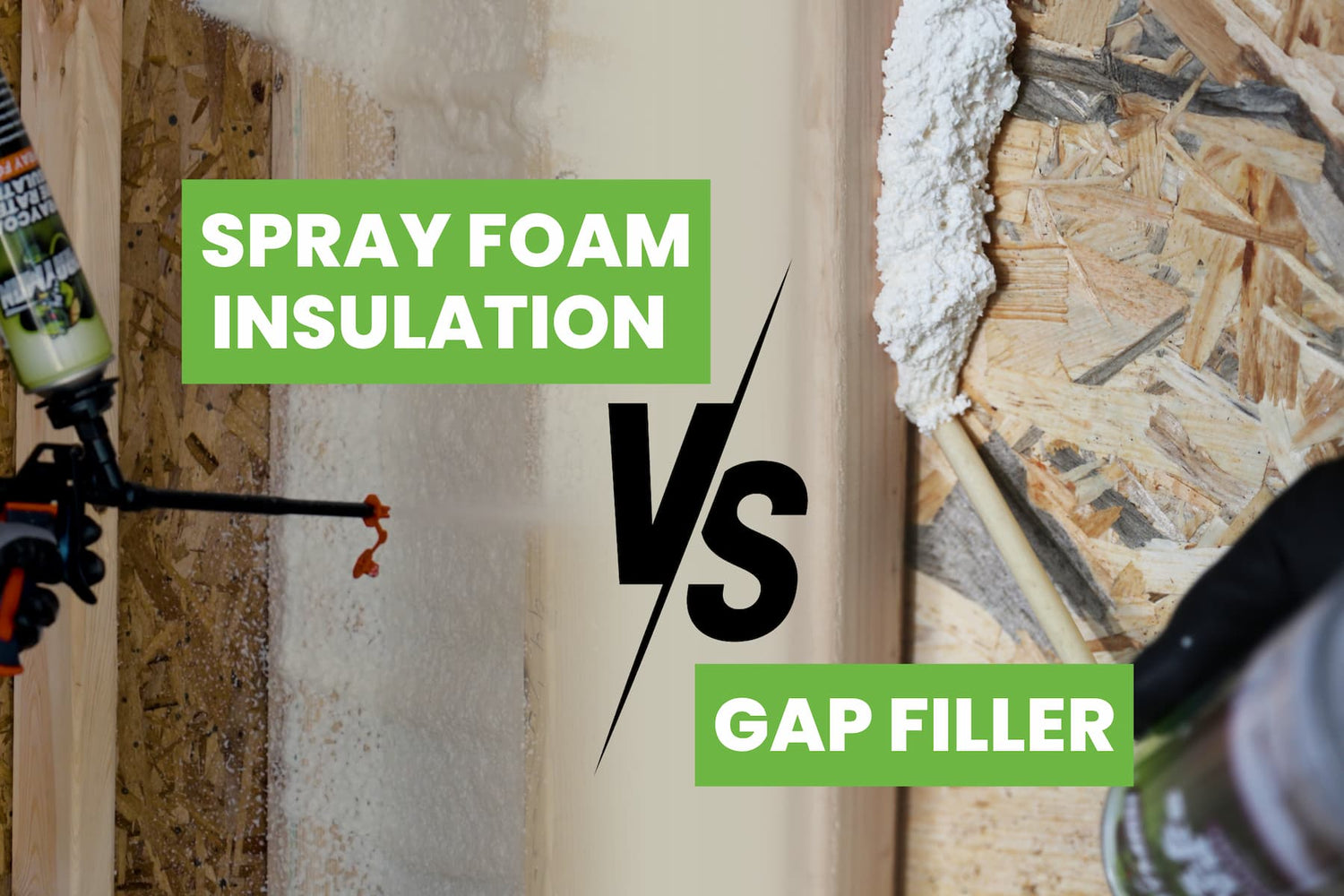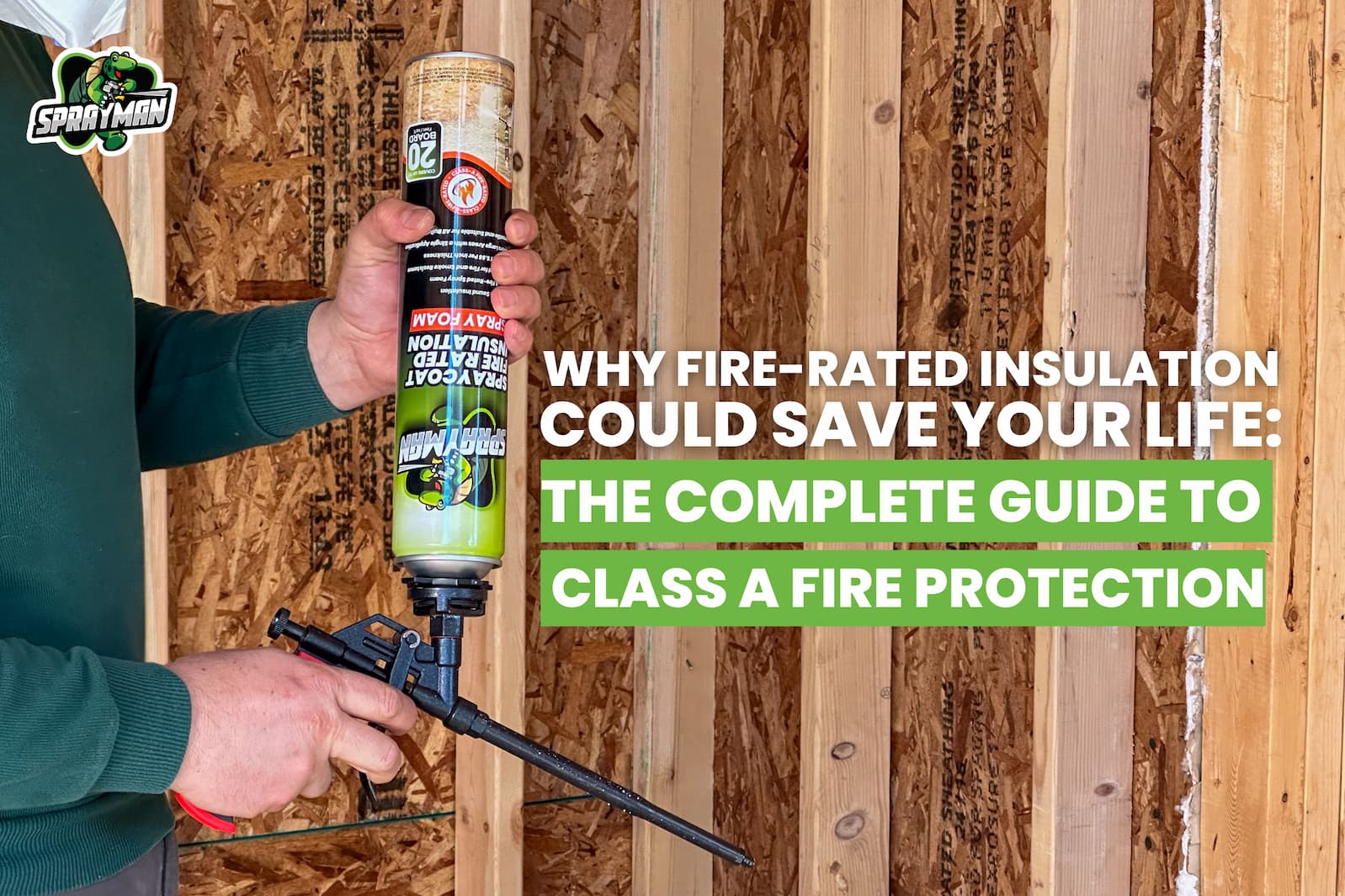Homeowners who want to insulate their homes or fix air leaks often face a common dilemma: should they buy diy spray foam insulation or gap filler foam? Both products expand to seal spaces, but choosing the wrong one can waste money and deliver poor results.
This comprehensive guide helps readers learn the key differences between insulation spray foam and gap filler foam. The guide reveals when to apply each product, how to compare their performance characteristics, and which option works best for specific project needs.
Whether planning a DIY attic insulation upgrade or simply needing to seal small cracks around windows, understanding these foam products ensures selecting the right solution. This blog post will help you to make an informed decision and encounter implementation methods that provide lasting results in home improvement projects.

What Is Spray Foam Insulation and How Does It Work?
Spray foam insulation is a building material used to insulate large areas. It creates a thermal barrier that stops heat transfer. This material keeps buildings warmer in the winter and cooler in the summer. It works through a chemical reaction. Two separate liquid components are mixed together in a spray gun. The mixture then sprays onto a surface, expands rapidly into a foam, and hardens into a solid layer of insulation.
What Is Gap Filler Foam and How Does It Work?
Gap filler foam is a sealant product. People use it to fill small cracks and openings. Its main purpose is to block drafts, moisture, and pests. Gap filler foam usually comes in an aerosol can. It is a single-component product. The foam leaves the can and reacts with moisture in the air. This reaction causes the foam to expand and cure, creating a durable seal.
What Are the Core Differences Between Spray Foam Insulation and Gap Filler Foam?
Understanding the differences between these foams ensures you use the right product. Each has a unique design and purpose.
|
Feature |
Spray Foam Insulation |
Gap Filler Foam |
|
Primary Use |
Insulating large areas (walls, attics) |
Sealing small gaps and cracks |
|
Application Scale |
Large-scale, often professional |
Small, DIY-friendly projects |
|
Composition |
Typically two-component |
Typically one-component |
|
Curing |
Chemical reaction between two parts |
Reacts with atmospheric moisture |
|
R-Value |
High (R-3.6 to R-8 per inch) |
Lower, primarily for air sealing |
|
Expansion |
High and controlled for filling cavities |
Variable (low to high) for filling gaps |
|
Structural Support |
Closed-cell can add strength |
No significant structural support |
1. Primary Purpose and Scale of Application
Spray foam insulation covers large, open areas. Think of wall cavities, attics, or crawl spaces. Its job is to provide a complete thermal envelope for a building.
Gap filler foam seals small, specific openings. Use it for cracks around windows, door frames, and where pipes enter walls. Its job is to seal, not insulate large surfaces.
2. Chemical Composition and Curing Process
Spray foam insulation is a two-component system. It has an isocyanate part and a polyol resin part. The two parts mix just before application, causing a chemical reaction that cures the foam quickly and uniformly.
Gap filler foam is a one-component system from a can. It needs moisture from the air to cure properly. This is why it works best in thin layers for small gaps.
3. Thermal Resistance (R-Value)
Spray foam insulation offers a high thermal resistance, or R-value. Closed-cell foam provides a high R-value, typically R-5.6 to R-8 per inch. Open-cell foam provides about R-3.6 per inch. This high R-value is key to its insulating power.
Gap filler foam has a much lower R-value. While it does block airflow, its main benefit is air sealing, not providing significant thermal resistance over an area.
4. Expansion Rate and Density
Spray foam insulation expands significantly to fill every part of a large cavity. It comes in two main densities. Open-cell foam is light and spongy. Closed-cell foam is dense and rigid.
Gap filler foam also expands, but less aggressively. Products are often labeled as "low-expansion" or "high-expansion." Low-expansion foam is ideal for delicate areas like window frames to prevent bending.
5. Structural Integrity
Spray foam insulation, specifically the closed-cell type, adds structural strength. Its dense, rigid nature helps reinforce the structure where it is applied.
Gap filler foam offers no structural support. It is a flexible sealant that fills a hole but does not strengthen the surrounding material.
6. Cost Benchmark
Spray foam insulation is a more expensive option. The material costs more, and professional installation requires specialized equipment. It is a significant investment in a building's energy efficiency.
Gap filler foam is very affordable. It is sold in small, single-use cans at most hardware stores. This makes it a cost-effective solution for small DIY sealing projects.
7. Fire Rating Options
Spray foam insulation products often have a Class A fire rating. This means they are treated with a fire retardant. Building codes require that all spray foam be covered by a 15-minute thermal barrier, such as drywall. These measures ensure full compliance and safety when working with fire rated spray foam insulation.
Gap filler foam is available in special "fireblock" versions. These foams are usually bright orange and are designed to slow the spread of fire and smoke through openings in walls and floors. Standard gap fillers do not have a fire rating.

When to Use Spray Foam Insulation?
Spray foam insulation should be used for large-scale projects where thermal performance is the main goal. Choose it for:
- Insulating open wall cavities in new construction.
- Upgrading attic or crawl space insulation.
- Creating an air and moisture barrier in basements and rim joists.
- Insulating commercial buildings or pole barns.
For a clear demonstration of these benefits and practical application tips, see the video below featuring Sprayman Insulation Spray Foam in action.
When Is a Gap Filler the Right Choice?
A gap filler is the right choice for small sealing jobs that improve a home's airtightness. Use it for:
- Sealing gaps around window and door frames.
- Filling holes where pipes or wires enter your home.
- Closing cracks in foundations or siding.
- Stopping drafts from electrical boxes.
See the tutorial below for a step-by-step demonstration of sealing windows and doors with Sprayman Window & Door Low-Expansion Spray Foam.
Can Spray Foam Insulation and Gap Fillers Be Used Together?
Yes, these products work very well together. A professional might use spray foam to insulate the walls of a new home. Afterward, the homeowner or a contractor can apply a gap filler like window & door spray foam to seal the small spaces around newly installed windows and doors. This combination creates a truly airtight and energy-efficient home.
What Are the Application Tips for DIYers and Professionals?
For DIYers using gap filler, always read the product instructions. Wear gloves and eye protection. Apply the foam slowly and remember it will expand, so do not overfill the gap. For delicate areas, choose a low-expansion foam.
For professionals using spray foam insulation, proper training and equipment are necessary. Full personal protective equipment (PPE), including a respirator, suit, and gloves, is required. Professionals must understand the chemical process and application techniques to ensure a safe and effective result.
Frequently Asked Questions (FAQs)
Here are answers to some common questions about using spray foam products.
What happens if I use gap filler to insulate a wall?
Using gap filler for a large space like a wall cavity is not effective. The foam is not designed for broad insulation, so it has a very low R-value. It also needs air to cure properly, so the foam in the center of the wall may remain wet and uncured. This will not provide the energy savings you need.
To understand how insulation is measured, read our detailed guide on the R-Value of Spray Foam Insulation.
Open-cell and closed-cell foam were mentioned. What is the difference?
These are the two main types of spray foam insulation. Closed-cell foam is dense, rigid, and acts as a barrier to both air and moisture. It has a higher R-value. Open-cell foam is lighter, more flexible, and acts as an excellent air barrier but not a moisture barrier. The best choice depends on your project's specific needs, like location and budget.
Learn which type is right for your project in our comparison: Closed-Cell vs. Open-Cell Spray Foam.
Can I do a large spray foam insulation project myself?
While gap fillers are very simple for DIY use, large-scale spray foam insulation is more complex. It often requires professional equipment and safety gear. However, there are DIY spray foam kits available for medium-sized projects like sealing a rim joist or insulating a small outbuilding.
For more information on handling your own project, see our Spray Foam Insulation DIY Guide.
Is there a specific foam I must use around my windows and doors?
Yes. You should use a windows and doors low-expansion gap filler. Standard high-expansion foams can expand with enough force to warp or bow window frames and door jambs, preventing them from opening or closing correctly.
Is all spray foam waterproof?
Not all foam is waterproof. Closed-cell spray foam insulation is water-resistant and acts as a moisture barrier, making it a great choice for basements, crawl spaces, and metal buildings. Open-cell foam is not waterproof and can absorb water. Standard gap fillers are water-resistant once cured, but not fully waterproof for submerged use.
Discover more about this topic here: Is Spray Foam Waterproof?
How much does spray foam insulation cost compared to canned gap filler?
Canned gap filler is very inexpensive, typically costing just a few dollars per can for small DIY jobs. Spray foam insulation is a much larger investment. Its cost is calculated by the board foot and depends on the foam type, project size, and labor.
Get a complete price breakdown in our guide to Spray Foam Insulation Cost.




Leave a comment
This site is protected by hCaptcha and the hCaptcha Privacy Policy and Terms of Service apply.